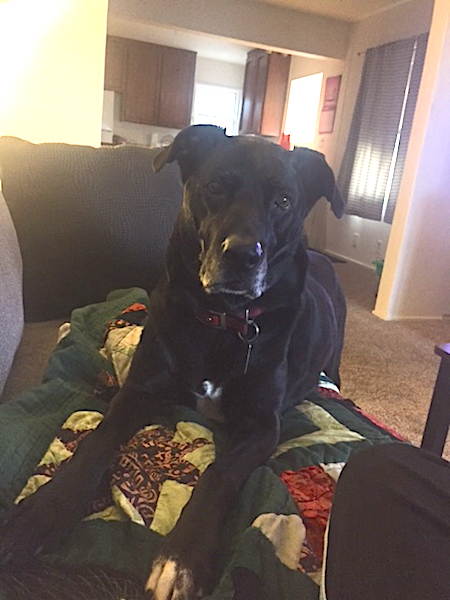A Model for Compassionate and Affordable Healthcare
As we in the United States struggle to find ways to fix our broken health care system, we have within our midst a good model of what health care could be in this country. As it stands now, health insurance is still unaffordable for many and coverage varies widely depending on your plan. The Affordable Care Act made some progress in this area, but there is still a long way to go. As Carolyn has shown us in her essay series “Dog Days of Cancer,” dealing with serious illness is a bureaucratic nightmare for many patients, and compassion and concern are seriously lacking. We repeatedly saw Carolyn and her husband Jack struggle to get answers, consistency in care, and to find someone who seemed to give a damn. Since my dog Kalli was diagnosed with lymphoma at the end of October, I have seen something very different.
Kalli is a beautiful being, in every sense of the word. A Black Labrador mix, she is tall, graceful, and solid black except for one white paw and a white patch on her chest. She is a complete sweetheart and has been my most devoted companion. She is at once a sympathetic adult and a very loving child. When her veterinarian told me she had acute stage IV lymphoma, I began to prepare myself to say goodbye. “Well, it can be treated,” said my vet. “I’ll refer you a specialist and you can talk to them.” That specialist was Dr. Erica Moore at Marqueen Pet Emergency & Specialty Group in Roseville. The office called me the same day and scheduled an appointment for the next morning. When I called Kalli’s regular vet to see if I needed to come back and pick up her records to take with me, I was told they had already been sent. I didn’t even have to ask.
We met with Dr. Moore the next morning, and within 2 or 3 hours Kalli was examined and evaluated. We were given treatment plans and a written cost estimate. Her doctor explained that chemotherapy for animals entails no discomfort or side effects and that this is one of the main goals for the patient. We agreed on a plan and Kalli got her first treatment. She started feeling better almost immediately. Since then we have gone in once a week for treatment, and Kalli has no more signs of illness. These are the types of experiences we have had over the last two months:
- A vet technician holding my 80-pound dog in her lap and singing to her to comfort her on her first visit.
- Contact with the same technician and same oncologist every week (for both of us).
- Every week I fill out an evaluation form on how Kalli is doing at home. Every week I receive a written report from her doctor about the day’s results and instructions for the next week, along with a few words of encouragement. (i.e. “Your girl looks great! We hope you guys are having a fantastic New Year.”)
- Efforts on the part of the clinic to keep the costs down, such as finding the cheapest pharmacy for what she needs, or telling me when tests would be helpful but not necessary so I can elect to skip them.
- Appointments are made at my convenience and I have never had to wait even one minute past the appointment time.
- Special efforts are made to make sure the patient is comfortable at all times, including while in the clinic. These efforts include speaking in high squeaky voices, taking the time to find out what kind of treats Kalli likes, making slight adjustments to her chemo protocol to manage potential side effects, and just making sure she is not suffering in any way.
- Most of all, they all seem to share my happiness that the big girl is doing well and feels good. Recently Kalli and her oncologist came running out of the exam room, one giddy because she had gotten special Christmas treats, and one giddy because her patient was doing so well. Kalli’s care providers do not for one minute underestimate the value of love and kindness when treating the sick.
Compare this to what Jack and Carolyn went through. Why can’t people be treated like my dog? What are the differences? I don’t know what the exact answer or answers are, but here are some ideas.
- When a person has cancer, you’re trying to cure them of the disease for the rest of their natural life, which could be 10, 20, or more years. With an animal that isn’t required, so we don’t have to wallop them with high doses of chemotherapy. Just enough is given to put them in remission and make them feel good. And, if it doesn’t work, we can humanely let them go. I don’t think this translates easily to human health care, though in some cases it may be worth thinking about dosages and results. Are we so focused on outcomes we forget what the patient is going through right here and now?
- Insurance is not such a large factor in pet care. The veterinary clinic is a profit-making business, no doubt about that, and treatment is not super cheap. However, I can manage it quite easily and I am far from wealthy. According to the American Veterinary Medical Association as of 2011, 5.7 percent of Americans had insurance for their dogs and 2.6 percent had insurance for their cats. These numbers have probably risen somewhat, but vets are still incentivized to keep costs down or no one would use their services. Insurance isn’t making decisions either, so there is no bureaucracy. Her doctor and I make all the decisions.
- I think it’s possible that some health care providers become burned out because of the for-profit insurance companies and their bureaucracies, by high caseloads, and other stressors that may cause them to lose compassion for their patients. I don’t believe this is a universal problem, as I have come across many caring health care providers over the years. Maybe dealing with animals is easier and less complicated than dealing with people, although there are the over anxious pet parents always in the picture.
We can address some of these problems by switching to universal health care, as all other first world countries have done. No, it does not solve every single problem, but it would be a huge step in the right direction. Carolyn has also written about the value of palliative care, as opposed to curative care, which emphasizes quality of life issues, such as confusion, anxiety, depression, pain, and weakness. It can be used in conjunction with curative care, and may include things like massage, counseling, pain management, and assistance at home. Unlike hospice, it is not only for the dying, but for anyone with a serious or chronic medical condition. I mean, why wouldn’t we want to do this? Interestingly, a commitment to palliative care is part of Marqueen’s mission statement. And yet in the human world there is resistance to something so relatively easy and low cost to implement. Just yesterday a coworker was telling me about a friend with neuropathy who was unable to find relief with traditional medical solutions. His sister suggested a homeopathic treatment, and it worked! When he excitedly told his doctor, his doctor said,” Great, then you never need to see me again.” His relationship with his doctor ended because something that wasn’t mainstream cured the patient’s pain.
Meanwhile, I hope and pray that if I ever get really sick, I’m treated like a dog.


Truly a thought provoking and heart feeling read.
Thank you Dawn!
Bravo, dear Stephanie. Send your essay to your Congress Woman and be heard! ♥️❤️💝😍💖
Thank you for your encouraging words Linda. We’re brainstorming ways to reach more people about this topic.
I appreciate this post, but as a specialized dietitian who has only worked at university based hospitals/ medical centers, this touches on our issues in healthcare, but avoids the reasons for some of our waste and high costs. The line where the author states that we let go of our animals humanely, starts to touch base on some of the high costs. I work mostly in specialized biochemical genetics with individuals with genetic conditions which affect their metabolism. These are severe illnesses which are chronic in nature. One thing I remember is a patient who was brain dead, but the parents with their limited education did not understand this. They refused to allow the child to pass away with life support removed. The child laid in a bed for 9 years which cost the State of California ~ $50,000 per year. As a specialized dietitian for this patient, I had so few resources to use for this family and was poorly paid myself as so much of the care I provided I could not bill for. I have done work in other areas and one of them was pediatric oncology. As the inpatient dietitian, I saw people towards the end of their life. When the hospital did a study, we realized that we were using IV nutrition on those who were dying. The IV nutrition was not curing their cancer. Sometimes the patient was laying in bed for months before the family came to terms with the situation. The IV nutrition and all the other care was exceptionally expensive. The answers are not easy. Healthcare is complex at best – even when it is under a single payer or national program. What is needed are discussions – done in calmly where many Americans will need to make difficult decisions.
Thank you Debra for taking the time to comment about your professional experience. You bring up some really important points. As a society we really need to think about the way we allocate available funds as well as thinking about quality of life. I remember when my Dad was dying the doctor asked if we wanted to put him on a ventilator, feeding tube, etc. My Mom made the distinction between saving someone’s life, and extending someone’s life, and said no. While extremely difficult, this was the correct decision. It helped that we were all very clear on my Dad’s wishes before this even happened, so that’s an important discussion for all of us to have. I also think that a greater emphasis on palliative care would be helpful, as well as a more realistic attitude towards death. But, as you said, there is nothing simple about any of these issues. Thanks again for your perspective.